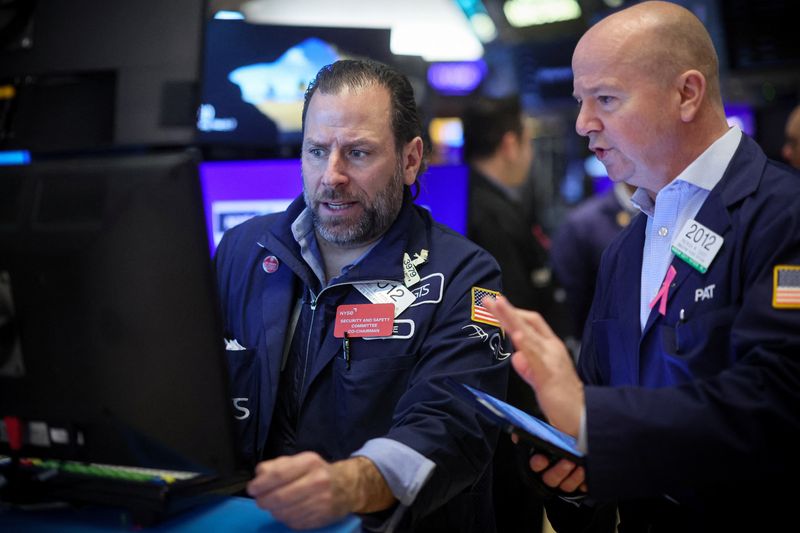By Jamie McGeever
ORLANDO, Florida (Reuters) - By some measures the U.S. stock market has not been this top-heavy in over 100 years and has just had one of its strongest rallies in decades, giving understandable rise to fears that a potentially large correction is imminent.
History suggests these fears may be overdone.
In the year following previous periods of extreme concentration, the S&P 500 rose more often than not, while rallies like the one just recorded over the past four months are always followed by 12 months of double-digit percentage returns.
Of course, no two macro or market environments are the same. And if the post-2008 and post-pandemic world has taught investors anything, it is that past performance is definitely no guarantee of future outcomes.
Still, they can provide useful guidance.
Concentration within the U.S. equity market has not been this high in decades, with the 10 largest U.S. stocks now accounting for 33% of S&P 500 market cap. A narrower measure constructed by analysts at Goldman Sachs shows that market concentration has never been higher.
S&P 500 returns in the 12 months after the 1973 and 2000 crashes fell 23% and 18%, respectively. But over seven periods of extreme concentration in the past century, including 1932, 1939, 1964, 2009 and 2020, average returns were 23% higher in the 12 months after.
"Historical episodes of elevated concentration were followed by S&P 500 rallies more often than corrections," notes Ben Snider, senior strategist at Goldman Sachs.
Comparisons with 2000 abound, but there are reasons to be optimistic. Snider calculates that the median valuation of today's top-10 stock is substantially lower than the comparable median in 2000, and the median top-10 market cap constituent is nearly three times more profitable than it was in 2000 or 1973.
The average S&P 500 stock is also relatively cheap. Analysts at Truist Advisory Services estimate that the S&P 500 Equal Weight Index is trading at a 20% discount to the traditional S&P 500, which is dominated by these mega tech and growth companies.
They say the equal-weighted index is showing signs of stabilizing after a period of underperformance, and reckon adding exposure to the equal-weighted index is one way to diversify within large caps.
Smaller caps are trading at an even deeper discount and are now near "extreme undervaluation" territory. If earnings momentum picks up, this is another sector in prime position to share the load.
SIT TIGHT
Market concentration in itself is not a sufficient trigger for a large drawdown. Nor is a long and steep rally.
By some measures, U.S. stocks are enjoying one of their strongest rallies in over 50 years and one of the strongest on record. The S&P 500 just rose 16 out of 18 weeks, a feat not achieved since 1971, gaining almost 25% in the process.
A period of consolidation or a near-term pullback would almost be expected, and Nvidia (NASDAQ:NVDA) losing more than 10% of its value since Friday may be the first sign that one is underway.
Analysts at Deutsche Bank say there have been five other episodes since the World War Two where the S&P 500 rose 21.5% or more in four months. Four were when the economy was emerging from recession, and one was during the dotcom bubble.
"So, you probably only need to worry if you think tech is in a bubble or if the recession has merely been postponed," wrote Deutsche's Jim Reid last week. "A relentless and aggressive rally is not in itself enough to justify a big correction."
But what if investors do take fright and start selling?
There is no template for what a drawdown looks like and history shows they come in all shapes and sizes. Recovery periods, the gap between the market's high-water mark and when it is next breached, vary wildly too.
The largest drawdown was 1929-1932 when stocks plunged 79% in real terms and full recovery, including reinvested income, wasn't achieved until February 1945, more than 15 years later.
The full drawdown and recovery from the dotcom crash of 52% in real terms lasted 7-1/2 years, while the market recovered its 35% real terms pandemic slump in 2020 within five months.
Investors' drawdown tolerance depends not only on their risk tolerance but their investment horizon - economic, financial and political crises come and go, but in the long run stocks tend to rise.
If you have the stomach and patience to ride out the volatility, sitting tight is perhaps the best policy.

"The largest drawdowns, like 2008, 2020, or even 2022, were usually sparked by a major shock. But we would always caution against panic and selling, especially for longer-term clients like pensions, retirement accounts, endowments," said Olaolu Aganga, U.S. chief investment officer at Mercer (NASDAQ:MERC).
(The opinions expressed here are those of the author, a columnist for Reuters)